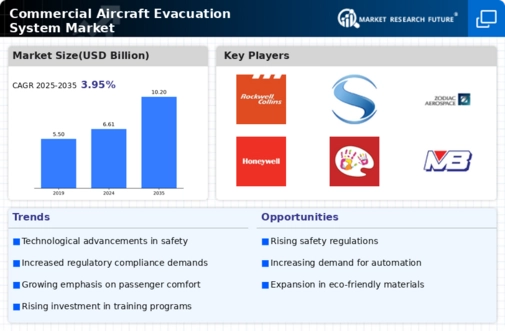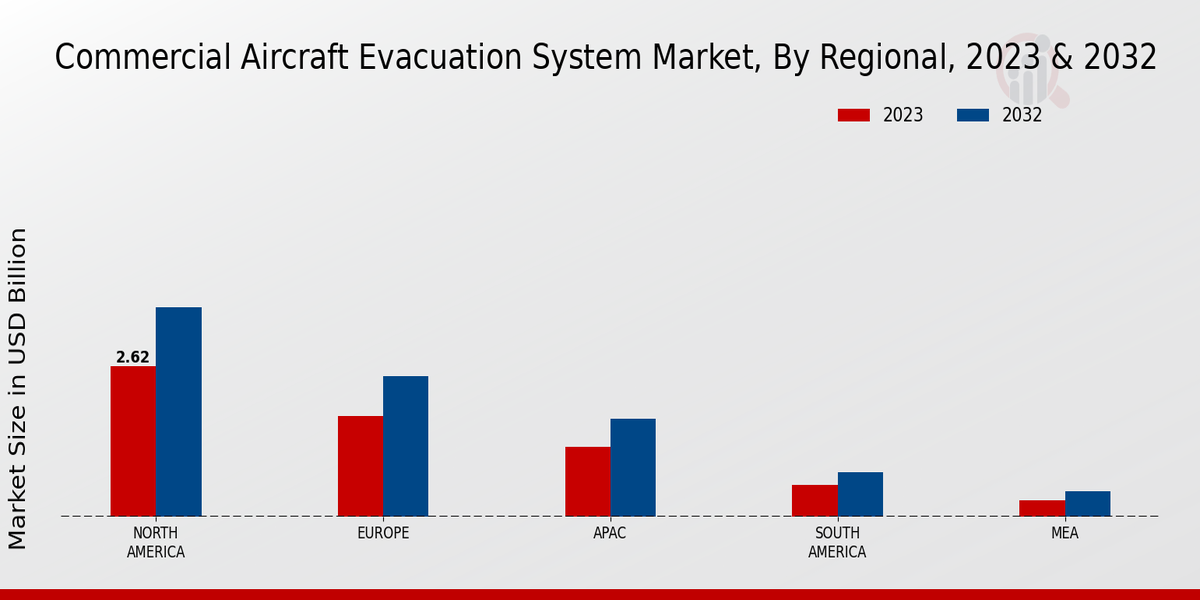Rising Air Travel Demand
The Global Commercial Aircraft Evacuation System Market Industry is also propelled by the increasing demand for air travel globally. With the rise in passenger numbers, airlines are compelled to enhance their fleet capabilities, which includes upgrading evacuation systems to meet higher safety standards. The International Air Transport Association (IATA) forecasts a steady growth in global air traffic, which necessitates the expansion of aircraft fleets. Consequently, this growth in air travel directly correlates with the demand for advanced evacuation systems, as airlines seek to ensure the safety of a larger number of passengers during emergencies.
Market Growth Projections
The Global Commercial Aircraft Evacuation System Market Industry is projected to experience notable growth in the coming years. With a market value of 6.61 USD Billion in 2024, it is anticipated to reach 10.2 USD Billion by 2035. This growth trajectory indicates a compound annual growth rate (CAGR) of 4.04% from 2025 to 2035. Such projections underscore the increasing investments in safety technologies and the continuous evolution of regulatory standards, which are likely to drive the demand for advanced evacuation systems across the global aviation sector.
Technological Advancements
Technological advancements play a pivotal role in shaping the Global Commercial Aircraft Evacuation System Market Industry. Innovations in materials, design, and automation have led to the development of more efficient and reliable evacuation systems. For instance, the integration of smart technologies, such as automated slide deployment and real-time monitoring systems, enhances evacuation efficiency and passenger safety. These advancements not only improve the overall performance of evacuation systems but also align with the evolving safety regulations. As airlines and manufacturers prioritize these technologies, the market is expected to witness substantial growth, driven by the demand for state-of-the-art evacuation solutions.
Focus on Passenger Experience
In the Global Commercial Aircraft Evacuation System Market Industry, there is a growing emphasis on enhancing passenger experience during emergencies. Airlines are increasingly aware that efficient evacuation systems not only save lives but also contribute to overall customer satisfaction. As a result, investments in user-friendly evacuation solutions, such as intuitive signage and improved slide designs, are becoming more prevalent. This focus on passenger experience is likely to drive innovation within the market, as companies strive to create systems that are not only effective but also easy to use in high-stress situations.
Increasing Safety Regulations
The Global Commercial Aircraft Evacuation System Market Industry is significantly influenced by the stringent safety regulations imposed by aviation authorities worldwide. Regulatory bodies such as the Federal Aviation Administration (FAA) and the European Union Aviation Safety Agency (EASA) continuously update safety standards to enhance passenger safety during emergencies. These regulations often necessitate the adoption of advanced evacuation systems, which could lead to increased investments in innovative technologies. As a result, the market is projected to grow from 6.61 USD Billion in 2024 to 10.2 USD Billion by 2035, reflecting a compound annual growth rate (CAGR) of 4.04% from 2025 to 2035.
Environmental Sustainability Initiatives
Environmental sustainability initiatives are emerging as a significant driver in the Global Commercial Aircraft Evacuation System Market Industry. As the aviation sector faces increasing scrutiny regarding its environmental impact, manufacturers are exploring eco-friendly materials and practices in the production of evacuation systems. This shift towards sustainability not only aligns with global efforts to reduce carbon footprints but also appeals to environmentally conscious consumers. Consequently, the market may witness a rise in demand for evacuation systems that utilize sustainable materials and practices, reflecting a broader trend towards environmental responsibility in the aviation industry.















